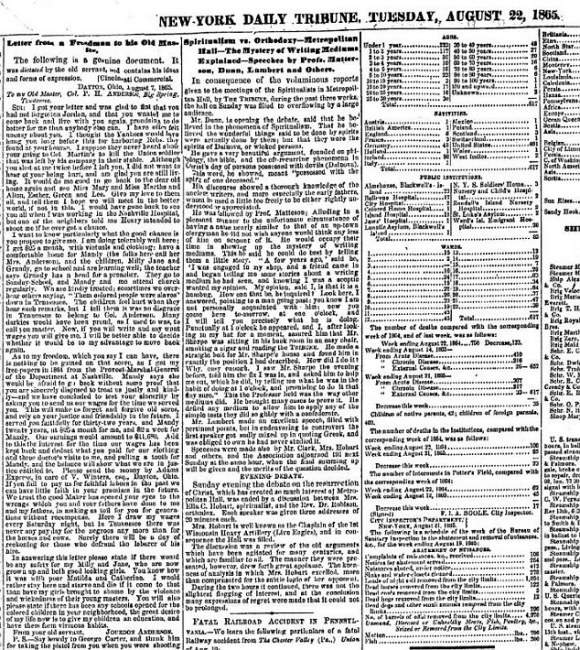Freed But Not Free

On December 6, 1865, the state of Georgia became the 27th state to ratify the Thirteenth Amendment to the Constitution. With that ratification, slavery was outlawed in the United States. For many former slaves, though, freedom came as a more direct byproduct of the Civil War, as Union troops, upon occupying a plantation, regularly emancipated the slaves held therein. Jordan Anderson, a slave born in Tennessee, was one of those freed by Northern soldiers. And a few months before the Thirteen Amendment became part of the Constitution, Jordan Anderson reminded his former owner of his freedom — and of a few other things.
Little is known about Anderson’s early life. In or around 1831, he — a young boy at age 7 or 8 — was sold into slavery, becoming the property of a general named Paulding Anderson. When the general passed away, his son Patrick inherited his estate, including Jordan (who “took” his owners’ last name). Jordan would work in the Anderson family’s service for three decades, until 1864, when Union soldiers overtook Tennessee. Some camped out on the Anderson plantation and also acted as liberators, freeing Jordan, his wife and children, and the other slaves there.
After the war, Patrick Anderson’s farm fell on hard times. This shouldn’t be surprising — the plantation had just hosted a war and much of its free labor was now gone. But come early 1865, Patrick Anderson was on the brink of bankruptcy. As what one hopes was a last-ditch effort, he wrote to his former slave Jordan, asking him to return to the plantation to work, with no mention of pay. Yes, he asked his former slave to return, willingly, to a life of low wages if not an outright return to slavery.
Jordan, by then, had started a new life as a free man in Ohio, and had found gainful employment (at $25 a month) with an abolitionist named Valentine Winters. Jordan, with Winters taking dictation, replied to Patrick via a letter. Winters urged his employee to allow newspapers to republish the letter, and Jordan agreed, as seen above. The letter, the full text of which is available here, is a sarcasm-laden missive which, quickly summarized, boils down to “go #$%^ yourself.” Some highlights:
- “I thought the Yankees would have hung you long before this for harboring Rebs they found at your house. I suppose they never heard about your going to Col. Martin’s to kill the Union soldier that was left by his company in their stable. Although you shot at me twice before I left you, I did not want to hear of your being hurt, and am glad you are still living.”
- “We have concluded to test your sincerity by asking you to send us our wages for the time we served you. This will make us forget and forgive old scores, and rely on your justice and friendship in the future. I served you faithfully for thirty-two years and Mandy [his wife] twenty years. At $25 a month for me, and $2 a week for Mandy, our earnings would amount to $11,680.” (In today’s dollars, that’s about $175,000.)
- “P.S.—Say howdy to George Carter, and thank him for taking the pistol from you when you were shooting at me.”
There’s no record of Patrick replying. However, his descendants did, according to the Daily Mail. In 2006, according to the British tabloid, a researcher named Raymond Winbush traced Patrick’s family tree and asked some members what they thought of Jordan’s reply. They were upset — “what’s amazing is that the current living relatives of Colonel Anderson are still angry at Jordan for not coming back,” said Winbush — because Patrick’s farm was failing and in dire need of help. Oh well.
Bonus fact: Sitting atop the U.S. Capitol is the “Statue of Freedom,” pictured here, which was commissioned, designed, and constructed in the mid-1850s and into the 1860s. According to the book “Liberty and Freedom,”the statue was originally designed wearing a “liberty cap,” which was an ancient Roman symbol for an emancipated slave. The cap, however, never made it into the final design. Jefferson Davis, a Senator from Mississippi, former U.S. Secretary of War, and of course, future President of the Confederacy, was the government official in charge of approving the final design, and as a slaveholder himself, he rejected that feature. And that isn’t the statue’s only tie-in to slavery. The statue was cast in 1861 or 1862, but before it was completed, the workers at the foundry went on strike. Instead of caving into the workers’ demands, the foundry owner had a man named Philip Reid supervise. Reid was a slave.
From the Archives: Free Shipping: A former slave’s creative route to freedom.
Related: “Liberty and Freedom” by David Hackett Fischer, cited above. 4.2 stars on 12 reviews. Available on Kindle.
